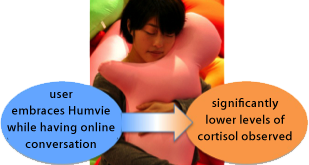
Huggable communication medium, Hugvie®, brings about a notable decrease in stress
"Feel the presence" even when distant
Advanced Telecommunications Research Institute International ( ATR ), Osaka University, and the Japan Science and Technology Agency have shown, by measuring hormonal changes in the body, that hugging a pillow-type communication medium, " Hugvie ," while conversing with another person, reduced stress. The hormonal changes which this group measured are considered useful data for the evaluation of the effectiveness of stress reduction and in the development of human-friendly communication media.
This all began with NTT Data Institute of Management Consulting, Inc. , establishing " Comfortable Brain Research Group" within Consortium for Applied Neuroscience managed by NTT Data Institute of Management Consulting, Inc. Once established, a project for investigating the feasibility of hormone tests was launched with several companies. The aim of the project was to establish a means for evaluating product effectiveness through hormone tests.
It has been clarified that interpersonal touch, such as a hug, offers health benefits such as stress reduction and the maintenance of good interpersonal relationships. This group produced Telenoid R1, a humanlike robotic creature (announced in August 2010) and confirmed that conversations, while hugging the robot, caused the persons having the conversation to "feel the presence" of the other and experience physical reactions similar to those brought about by actual touch.
This group, working on what became Hugvie, developed a somewhat more human-shaped cushion (which they called Hugvie) that functioned as a giant huggable mobile phone (announced in April 2012).
However, no actual physical data existed regarding the physical benefits of touch involving media such as the group was developing other than information obtained from questionnaires provided to test subjects about how they felt. For example, when a person hugs another it has been confirmed that the blood level of the hormone cortisol, which increases with stress, and the level of the subject’s heartbeat both decreased. If similar data could be shown for artificial media, it would be possible to say the importance of such communication media and the importance of developing new communication media has been confirmed.
This research showed a decrease in stress for subjects who engaged in a conversation while hugging a Hugvie. Subjects were divided into two groups: those who had a conversation while hugging a Hugvie and persons who had a conversation using just a cell phone. Blood levels of cortisol and levels of cortisol in saliva were measured both before and after the conversations. The results showed that the group who hugged a Hugvie during the conversation had significantly lower levels of cortisol in both their blood and saliva. These results showed that artificial media such as Hugvie are capable of producing stress-reduction levels similar to what one might find in subjects who hugged another person.
These results suggest new directions for interpersonal communication media. For example, as the effectiveness of communication media such as Hugvie has been confirmed, activities such as long-distance counseling become possible. Moreover, by evaluating products we use in our daily lives regarding physical reactions such products promote will lead the development of products which will more effectively support our health.
Abstract
Interpersonal touch is a fundamental component of social interactions because it can mitigate physical and psychological distress. To reproduce the psychological and physiological effects associated with interpersonal touch, interest is growing in introducing tactile sensations to communication devices. However, it remains unknown whether physical contact with such devices can produce objectively measurable endocrine effects like real interpersonal touching can. We directly tested this possibility by examining changes in stress hormone cortisol before and after a conversation with a huggable communication device. Participants had 15-minute conversations with a remote partner that was carried out either with a huggable human-shaped device or with a mobile phone. Our experiment revealed significant reduction in the cortisol levels for those who had conversations with the huggable device. Our approach to evaluate communication media with biological markers suggests new design directions for interpersonal communication media to improve social support systems in modern highly networked societies.
To learn more about this research, please read the full research report entitled " Huggable communication medium decreases cortisol levels " at this page of the Scientific Feports website.
Related link :
